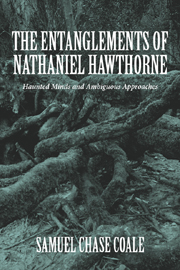Book contents
- Frontmatter
- Contents
- Acknowledgments
- List of Abbreviations
- Introduction: Entanglements
- 1 The Legacy of The Scarlet Letter: Hawthorne in Contemporary Culture
- 2 Hawthorne as Nineteenth-Century Morbid Genius
- 3 Biographical and Critical Veils in the Nineteenth Century
- 4 Biographical Visions of the Twentieth Century
- 5 Entangled Polarities: The New Criticism
- 6 Doubting Dualisms: The Strategies of Hawthorne's Romance
- 7 Ideological Contexts: Deconstruction, Feminism, the New Historicism, Race, and Entanglement
- Works Cited
- Index
1 - The Legacy of The Scarlet Letter: Hawthorne in Contemporary Culture
Published online by Cambridge University Press: 12 September 2012
- Frontmatter
- Contents
- Acknowledgments
- List of Abbreviations
- Introduction: Entanglements
- 1 The Legacy of The Scarlet Letter: Hawthorne in Contemporary Culture
- 2 Hawthorne as Nineteenth-Century Morbid Genius
- 3 Biographical and Critical Veils in the Nineteenth Century
- 4 Biographical Visions of the Twentieth Century
- 5 Entangled Polarities: The New Criticism
- 6 Doubting Dualisms: The Strategies of Hawthorne's Romance
- 7 Ideological Contexts: Deconstruction, Feminism, the New Historicism, Race, and Entanglement
- Works Cited
- Index
Summary
On June 22, 2006, an illustrated invitation arrived via email. It showed two women, one with a high starched collar and white bow, the other in the foreground, a nun, her face shrouded in a nun's habit in all of its whiteness with the black wimple curtaining it. The invitation read:
Public Ceremony
2:30 PM on June 26, 2006 at
The Old Manse
269 Monument Street
Concord, Massachusetts
Followed by
Reception & Refreshments
Graveside Visitation after 3 PM
Sleepy Hollow Cemetery — Author's Ridge
Hosted by
The Dominican Sisters of Hawthorne
And
The Help of the Good People of Concord
Preceding pages offered oval portraits of Sophia, Una, and Nathaniel Hawthorne to honor the memory of Sophia, Hawthorne's wife, and Una, their older daughter, “on the historic day of their re-interment alongside Nathaniel Hawthorne.” Their original graves in Kensal Green Cemetery, the oldest English cemetery still in operation in London, had fallen into disrepair over the years when a hawthorn tree, oddly enough, had fallen and damaged the original cemetery markers, knocking over Una's headstone. Sophia had been buried there in 1871 at sixty-two. Una had followed in 1877 at thirty-three. The Dominican nuns, a Catholic order established by Rose Hawthorne, Sophia and Nathaniel's younger daughter, to care for dying cancer patients in what was one of the first hospices of its kind, had taken care of the graves and had tried for many years to raise funds to move the remains to Concord. In 2003, Rose Hawthorne had been proposed as a candidate for sainthood.
- Type
- Chapter
- Information
- The Entanglements of Nathaniel HawthorneHaunted Minds and Ambiguous Approaches, pp. 5 - 19Publisher: Boydell & BrewerPrint publication year: 2011

